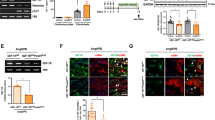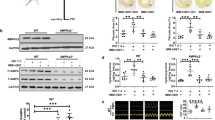Abstract
Angiotensin II (Ang II) plays an important role on the pathogenesis of cardiac fibrosis. Prolong and overstimulation of angiotensin II type 1 receptor with Ang II-induced collagen synthesis and myofibroblast differentiation in cardiac fibroblasts, leading to cardiac fibrosis. Although adenosine and its analogues are known to have cardioprotective effects, the mechanistic by which adenosine A2 receptors (A2Rs) inhibit Ang II-induced cardiac fibrosis is not clearly understood. In the present study, we examined the effects of exogenous adenosine and endogenous adenosine on Ang II-induced collagen and myofibroblast differentiation determined by α-smooth muscle action (α-SMA) overexpression and their underlying signal transduction. Elevation of endogenous adenosine levels resulted in the inhibition of Ang II-induced collagen type I and III and α-SMA synthesis in cardiac fibroblasts. Moreover, treatment with exogenous adenosine which selectively stimulated A2Rs also suppressed Ang II-induced collagen synthesis and α-SMA production. These antifibrotic effects of both endogenous and exogenous adenosines are mediated through the A2B receptor (A2BR) subtype. Stimulation of A2BR exhibited antifibrotic effects via the cAMP-dependent and Epac-dependent pathways. Our results provide new mechanistic insights regarding the role for cAMP and Epac on A2BR-mediated antifibrotic effects. Thus, A2BR is one of the potential therapeutic targets against cardiac fibrosis.








Similar content being viewed by others
Abbreviations
- α-SMA:
-
α-Smooth muscle actin
- AC:
-
Adenylate cyclase
- A2R:
-
Adenosine A2 receptor
- Ang II:
-
Angiotensin II
- cAMP:
-
Cyclic adenosine monophosphate
- DDA:
-
2′,5′-Dideoxyadenosine
- ECM:
-
Extracellular matrix
- EHNA:
-
Erythro-9-(2-hydroxy-3-nonyl) adenine
- Epac:
-
Exchange protein directly activated by cAMP
- ET-1:
-
Endothelin-1
- FCS:
-
Fetal calf serum
- IDO:
-
5-Iodotubericidin
- PKA:
-
Protein kinase A
- PKI:
-
Myristoylated protein kinase A inhibitor amide 14–22
- siRNA:
-
Small interfering RNA
- TGF-β:
-
Transforming growth factor beta
References
Porter KE, Turner NA (2009) Cardiac fibroblasts: at the heart of myocardial remodeling. Pharmacol Ther 123(2):255–278. https://doi.org/10.1016/j.pharmthera.2009.05.002
Vasquez C, Benamer N, Morley GE (2011) The cardiac fibroblast: functional and electrophysiological considerations in healthy and diseased hearts. J Cardiovasc Pharmacol 57(4):380–388. https://doi.org/10.1097/FJC.0b013e31820cda19
Kong P, Christia P, Frangogiannis NG (2014) The pathogenesis of cardiac fibrosis. Cell Mol Life Sci 71(4):549–574. https://doi.org/10.1007/s00018-013-1349-6
Kurose H, Mangmool S (2016) Myofibroblasts and inflammatory cells as players of cardiac fibrosis. Arch Pharm Res 39(8):1100–1113. https://doi.org/10.1007/s12272-016-0809-6
Lijnen PJ, Petrov VV, Fagard RH (2000) Induction of cardiac fibrosis by angiotensin II. Methods Find Exp Clin Pharmacol 22(10):709–723. https://doi.org/10.1358/mf.2000.22.10.802287
Holtz J (1993) Pathophysiology of heart failure and the renin-angiotensin-system. Basic Res Cardiol 88(Suppl 1):183–201
Pedram A, Razandi M, O'Mahony F, Lubahn D, Levin ER (2010) Estrogen receptor-beta prevents cardiac fibrosis. Mol Endocrinol 24(11):2152–2165. https://doi.org/10.1210/me.2010-0154
Schnee JM, Hsueh WA (2000) Angiotensin II, adhesion, and cardiac fibrosis. Cardiovasc Res 46(2):264–268. https://doi.org/10.1016/S0008-6363(00)00044-4
Crawford DC, Chobanian AV, Brecher P (1994) Angiotensin II induces fibronectin expression associated with cardiac fibrosis in the rat. Circ Res 74(4):727–739. https://doi.org/10.1161/01.RES.74.4.727
Kawano H, Cody RJ, Graf K, Goetze S, Kawano Y, Schnee J, Law RE, Hsueh WA (2000) Angiotensin II enhances integrin and alpha-actinin expression in adult rat cardiac fibroblasts. Hypertension 35(1):273–279. https://doi.org/10.1161/01.HYP.35.1.273
Villarreal F, Zimmermann S, Makhsudova L, Montag AC, Erion MD, Bullough DA, Ito BR (2003) Modulation of cardiac remodeling by adenosine: in vitro and in vivo effects. Mol Cell Biochem 251(1/2):17–26. https://doi.org/10.1023/A:1025401026441
Phosri S, Arieyawong A, Bunrukchai K, Parichatikanond W, Nishimura A, Nishida M, Mangmool S (2017) Stimulation of adenosine A2B receptor inhibits Endothelin-1-induced cardiac fibroblast proliferation and alpha-smooth muscle actin synthesis through the cAMP/Epac/PI3K/Akt-signaling pathway. Front Pharmacol 8:428. https://doi.org/10.3389/fphar.2017.00428
Dubey RK, Gillespie DG, Zacharia LC, Mi Z, Jackson EK (2001) A(2b) receptors mediate the antimitogenic effects of adenosine in cardiac fibroblasts. Hypertension 37(2):716–721. https://doi.org/10.1161/01.HYP.37.2.716
Villarreal F, Epperson SA, Ramirez-Sanchez I, Yamazaki KG, Brunton LL (2009) Regulation of cardiac fibroblast collagen synthesis by adenosine: roles for Epac and PI3K. Am J Phys Cell Physiol 296(5):C1178–C1184. https://doi.org/10.1152/ajpcell.00291.2008
Epperson SA, Brunton LL, Ramirez-Sanchez I, Villarreal F (2009) Adenosine receptors and second messenger signaling pathways in rat cardiac fibroblasts. Am J Phys Cell Physiol 296(5):C1171–C1177. https://doi.org/10.1152/ajpcell.00290.2008
Dubey RK, Gillespie DG, Jackson EK (1998) Adenosine inhibits collagen and protein synthesis in cardiac fibroblasts: role of A2B receptors. Hypertension 31(4):943–948. https://doi.org/10.1161/01.HYP.31.4.943
Dubey RK, Gillespie DG, Mi Z, Jackson EK (1997) Exogenous and endogenous adenosine inhibits fetal calf serum-induced growth of rat cardiac fibroblasts: role of A2B receptors. Circulation 96(8):2656–2666. https://doi.org/10.1161/01.CIR.96.8.2656
Smolenski RT, Kochan Z, McDouall R, Page C, Seymour AL, Yacoub MH (1994) Endothelial nucleotide catabolism and adenosine production. Cardiovasc Res 28(1):100–104. https://doi.org/10.1093/cvr/28.1.100
Cohen MV, Downey JM (2008) Adenosine: trigger and mediator of cardioprotection. Basic Res Cardiol 103(3):203–215. https://doi.org/10.1007/s00395-007-0687-7
Jacobson KA, Gao ZG (2006) Adenosine receptors as therapeutic targets. Nat Rev Drug Discov 5(3):247–264. https://doi.org/10.1038/nrd1983
Vecchio EA, Chuo CH, Baltos JA, Ford L, Scammells PJ, Wang BH, Christopoulos A, White PJ, May LT (2016) The hybrid molecule, VCP746, is a potent adenosine A2B receptor agonist that stimulates anti-fibrotic signalling. Biochem Pharmacol 117:46–56. https://doi.org/10.1016/j.bcp.2016.08.007
Wakeno M, Minamino T, Seguchi O, Okazaki H, Tsukamoto O, Okada K, Hirata A, Fujita M, Asanuma H, Kim J, Komamura K, Takashima S, Mochizuki N, Kitakaze M (2006) Long-term stimulation of adenosine A2b receptors begun after myocardial infarction prevents cardiac remodeling in rats. Circulation 114(18):1923–1932. https://doi.org/10.1161/CIRCULATIONAHA.106.630087
Klinger M, Freissmuth M, Nanoff C (2002) Adenosine receptors: G protein-mediated signalling and the role of accessory proteins. Cell Signal 14(2):99–108. https://doi.org/10.1016/S0898-6568(01)00235-2
Swaney JS, Roth DM, Olson ER, Naugle JE, Meszaros JG, Insel PA (2005) Inhibition of cardiac myofibroblast formation and collagen synthesis by activation and overexpression of adenylyl cyclase. Proc Natl Acad Sci U S A 102(2):437–442. https://doi.org/10.1073/pnas.0408704102
Lu D, Aroonsakool N, Yokoyama U, Patel HH, Insel PA (2013) Increase in cellular cyclic AMP concentrations reverses the profibrogenic phenotype of cardiac myofibroblasts: a novel therapeutic approach for cardiac fibrosis. Mol Pharmacol 84(6):787–793. https://doi.org/10.1124/mol.113.087742
Nuamnaichati N, Sato VH, Moongkarndi P, Parichatikanond W, Mangmool S (2017) Sustained β-AR stimulation induces synthesis and secretion of growth factors in cardiac myocytes that affect on cardiac fibroblast activation. Life Sci. https://doi.org/10.1016/j.lfs.2017.10.034
Mangmool S, Denkaew T, Phosri S, Pinthong D, Parichatikanond W, Shimauchi T, Nishida M (2016) Sustained βAR stimulation mediates cardiac insulin resistance in a PKA-dependent manner. Mol Endocrinol 30(1):118–132. https://doi.org/10.1210/me.2015-1201
Insel PA, Murray F, Yokoyama U, Romano S, Yun H, Brown L, Snead A, Lu D, Aroonsakool N (2012) cAMP and Epac in the regulation of tissue fibrosis. Br J Pharmacol 166(2):447–456. https://doi.org/10.1111/j.1476-5381.2012.01847.x
Kawano H, Do YS, Kawano Y, Starnes V, Barr M, Law RE, Hsueh WA (2000) Angiotensin II has multiple profibrotic effects in human cardiac fibroblasts. Circulation 101(10):1130–1137. https://doi.org/10.1161/01.CIR.101.10.1130
Schieffer B, Wirger A, Meybrunn M, Seitz S, Holtz J, Riede UN, Drexler H (1994) Comparative effects of chronic angiotensin-converting enzyme inhibition and angiotensin II type 1 receptor blockade on cardiac remodeling after myocardial infarction in the rat. Circulation 89(5):2273–2282. https://doi.org/10.1161/01.CIR.89.5.2273
Regan CP, Anderson PG, Bishop SP, Berecek KH (1997) Pressure-independent effects of AT1-receptor antagonism on cardiovascular remodeling in aortic-banded rats. Am J Phys 272:H2131–H2138
Fredholm BB, Arslan G, Halldner L, Kull B, Schulte G, Wasserman W (2000) Structure and function of adenosine receptors and their genes. Naunyn Schmiedeberg's Arch Pharmacol 362(4-5):364–374. https://doi.org/10.1007/s002100000313
Vecchio EA, White PJ, May LT (2017) Targeting adenosine receptors for the treatment of cardiac fibrosis. Front Pharmacol 8:243. https://doi.org/10.3389/fphar.2017.00243
Zimmerman MA, Tak E, Ehrentraut SF, Kaplan M, Giebler A, Weng T, Choi DS, Blackburn MR, Kam I, Eltzschig HK, Grenz A (2013) Equilibrative nucleoside transporter (ENT)-1-dependent elevation of extracellular adenosine protects the liver during ischemia and reperfusion. Hepatology 58(5):1766–1778. https://doi.org/10.1002/hep.26505
Eltzschig HK, Faigle M, Knapp S, Karhausen J, Ibla J, Rosenberger P, Odegard KC, Laussen PC, Thompson LF, Colgan SP (2006) Endothelial catabolism of extracellular adenosine during hypoxia: the role of surface adenosine deaminase and CD26. Blood 108(5):1602–1610. https://doi.org/10.1182/blood-2006-02-001016
Jackson EK, Koehler M, Mi Z, Dubey RK, Tofovic SP, Carcillo JA, Jones GS (1996) Possible role of adenosine deaminase in vaso-occlusive diseases. J Hypertens 14(1):19–29
Hori M, Kitakaze M (1991) Adenosine, the heart, and coronary circulation. Hypertension 18(5):565–574. https://doi.org/10.1161/01.HYP.18.5.565
Lagerkranser M, Sollevi A, Irestedt L, Tidgren B, Andreen M (1985) Renin release during controlled hypotension with sodium nitroprusside, nitroglycerin and adenosine: a comparative study in the dog. Act Aneasthesiol Scand 29(1):45–49. https://doi.org/10.1111/j.1399-6576.1985.tb02157.x
Chen Y, Epperson S, Makhsudova L, Ito B, Suarez J, Dillmann W, Villarreal F (2004) Functional effects of enhancing or silencing adenosine A2b receptors in cardiac fibroblasts. Am J Physiol Heart Circ Physiol 287(6):H2478–H2486. https://doi.org/10.1152/ajpheart.00217.2004
Asakura M, Asanuma H, Kim J, Liao Y, Nakamaru K, Fujita M, Komamura K, Isomura T, Furukawa H, Tomoike H, Hitakaze M (2007) Impact of adenosine receptor signaling and metabolism on pathophysiology in patients with chronic heart failure. Hypertens Res 30(9):781–787. https://doi.org/10.1291/hypres.30.781
Shaikh G, Cronstein B (2016) Signaling pathways involving adenosine A2A and A2B receptors in wound healing and fibrosis. Purinergic Signal 12(2):191–197. https://doi.org/10.1007/s11302-016-9498-3
Godinho RO, Duarte T, Pacini ES (2015) New perspectives in signaling mediated by receptors coupled to stimulatory G protein: the emerging significance of cAMP e ffl ux and extracellular cAMP-adenosine pathway. Front Pharmacol 6:58
Fang Y, Olah ME (2007) Cyclic AMP-dependent, protein kinase A-independent activation of extracellular signal-regulated kinase 1/2 following adenosine receptor stimulation in human umbilical vein endothelial cells: role of exchange protein activated by cAMP 1 (Epac1). J Pharmacol Exp Ther 322(3):1189–1200. https://doi.org/10.1124/jpet.107.119933
Acknowledgements
This study is funded by the Thailand Research Fund (TRF) through the Royal Golden Jubilee Ph.D. Program, the Office of the Higher Education Commission, Ministry of Education [Grant PHD/0179/2558] (to S.P.) and TRF Grant [Grant RSA6080061] (to S.M.). This study is part of a Ph.D. thesis of Mahidol University.
Author information
Authors and Affiliations
Contributions
Participated in the study planning: S.P. and S.M.
Performed experiments and data analysis: S.P., K.B., and S.M.
Contributed to the discussion and reviewed/edited the manuscript: W.P. and V.H.S.
Wrote the manuscript: S.P. and S.M.
Corresponding author
Ethics declarations
Conflicts of interest
Sarawuth Phosri declares that he has no conflict of interest.
Kwanchai Bunrukchai declares that he has no conflict of interest.
Warisara Parichatikanond declares that she has no conflict of interest.
Vilasinee H. Sato declares that she has no conflict of interest.
Supachoke Mangmool declares that he has no conflict of interest.
Ethical approval
This study was approved by the Institutional Animal Care and Use Committee of the Faculty of Pharmacy, Mahidol University (Protocol Nos. PYR005/2557 and PYR002/2560).
Electronic supplementary material
ESM 1
(DOCX 16 kb)
Fig. S1
Effects of endogenous adenosine on Ang II-induced collagen and α-SMA synthesis. Cardiac fibroblasts were either pretreated with EHNA (1, 10 μM) or IDO (1, 10 μM) for 1 h and then stimulated with 200 nM Ang II for 6 h. Relative collagen I, collagen III, and α-SMA mRNA levels were quantified and shown as the mean±SEM (n = 4). * Significant difference (P < 0.05) versus vehicle (control); #Significant difference (P < 0.05) versus Ang II. (GIF 45 kb)
Rights and permissions
About this article
Cite this article
Phosri, S., Bunrukchai, K., Parichatikanond, W. et al. Epac is required for exogenous and endogenous stimulation of adenosine A2B receptor for inhibition of angiotensin II-induced collagen synthesis and myofibroblast differentiation. Purinergic Signalling 14, 141–156 (2018). https://doi.org/10.1007/s11302-017-9600-5
Received:
Accepted:
Published:
Issue Date:
DOI: https://doi.org/10.1007/s11302-017-9600-5




